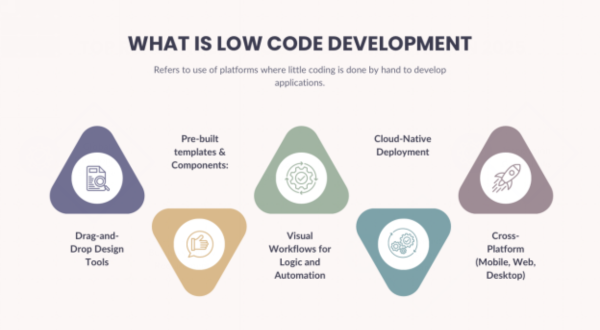
Why Low-Code Development Is Surging in 2025
The nature of business application development is changing seismically in 2025. The long-established code-heavy development methods that were the usual way of doing things are being overtaken by low-code platforms, which can deliver apps in record time with minimal manual code. This is not a fad; it is a response to real business needs: time to market, cost efficiency and democratisation of innovation.
Low-code platforms enable enterprises to create strong and scalable apps using a visual interface, drag and drop interface and pre-built components. Be it a startup or a fortune 500 business, low-code platforms are being integrated to help businesses in their digital transformation initiatives, cut down on their operations, and respond to the changes in the market.
What is Low-Code Development? A 2025 Guide
Low-code development is the use of platforms where little coding is done by hand to develop applications. Developers design and model applications using graphical user interfaces and configuration tools as opposed to writing thousands of lines of code.
Core Features of Low-Code Platforms in 2025:
● Drag-and-Drop Design Tools:
Drag and drop design interface is one of the basic advantages of low-code platforms as it allows users to design application interfaces visually without writing complicated code. Instead of coding each button, each form or layout element on a page separately, the user needs only to drag the items out of a toolbox and drop them on a canvas. It minimises the possibility of UI errors and ensures design consistency between applications.
● Pre-built templates & Components:
Low-code solutions are already supplied with a set of pre-built templates and reusable objects, i.e., login pages, dashboards, approval processes, data tables, etc. These ready-made components enable users to build applications in a short time without building them entirely. Templates can be used to give a strong basis for the commonly used cases whereas the components are used to make the design and structure consistent.
Not only does this speed up the development process but it also minimises errors and stipulates best practices and therefore facilitates an increase in the rate of app-building as well as makes it more convenient to both technical and non-technical users.
● Visual Workflows for Logic and Automation:
Low-code gives the user the ability to specify business logic and automation using visual workflow editors. As opposed to the complicated backend coding, the users are able to map out processes with the use of flowcharts, decision trees, and triggers all in a user-intuitive interface.
● Cloud-Native Deployment:
Low-code platforms are usually constructed on cloud-native, which enables applications to be launched in the cloud with little configuration. It gives automatic updates, real-time backups, global availability, and connects to other cloud services.
● Cross-Platform (Mobile, Web, Desktop):
With the help of this feature, applications are automatically responsive to the various screen sizes and operating systems with built-in responsiveness and adaptive design tools.
This cross-platform feature can do away with the process of creating an entirely different version of the same product on each gadget and it saves both time and resources. Your users could be on Android, iOS, a browser, or a desktop application, and low-code would allow a smooth experience and unification of code base across all platforms.
Top Reasons Low-Code Is Dominating in 2025
-
- Global Developer Shortage
The world is facing a shortage of good developers. Low-code will help to address this talent shortfall by allowing non-technical users (citizen developers) to create apps without having to lean exclusively on IT departments.
-
- Business Agility Requirement
Markets are dynamic and businesses require dynamic tools. Low-code platforms enable businesses to go through rapid prototyping and deploy apps within weeks, not months.
-
- Cost Optimization
Companies can save a lot of money in terms of development costs, hiring, training and infrastructure with low-code. A lot of platforms are cloud-native which minimises on-premise investments.
-
- Powered Business Teams
Low-code allows business users (e.g. operations, HR, marketing) to build the tools that they need themselves--breaking the bottlenecks and becoming less IT dependent.
-
- Integration Capabilities
The most popular enterprise systems (e.g. SAP, Salesforce, Oracle) can be perfectly integrated with low-code platforms of today using APIs and connectors.
Use Cases of Low-Code
The use of low-code is observed in every industry and business activity. These are such strong examples:
1. Employee and HR Portals
To build apps used in onboarding, leave management, and performance tracking, HR teams develop them without having to write a single line of code.
2. Supply Chain and Logistics
The low-code apps can track shipments, manage inventory, and automate vendor communications- which are critical to real-time decision making in the supply chains.
3. Finance and Compliance
The low-code is adopted to automate the processes of invoice approval, report creation, and regulatory compliance of the finance department.
4. Healthcare Solutions
The patient tracking systems, appointment scheduling tools, and remote diagnostics mobile apps can be built with the help of low-code by hospitals.
Low-Code vs Traditional App Development: Which Is Better in 2025?
| Feature | Low-Code Development | Traditional Development |
| Speed | Weeks | Months |
| Cost | Low | High |
| Flexibility | Moderate to High | Very High |
| Skill Requirement | Low to Medium | High |
| Maintenance | Easier, Platform Supported | Developer-Intensive |
| Scalability | Improved in 2025 | Custom Built |
Although traditional development is still useful with the most complex and performance-sensitive applications, most internal tools and business process applications today are developed using low-code.
Digital Transformation Powered by Low-Code and Intelligent Automation
It is expected that low-code development will be strongly related to such intelligent automation technologies as AI, RPA (Robotic Process Automation), and ML (Machine Learning) in 2025.
The Way They Are Collaborating:
-
- The low-code apps have AI-powered bots to facilitate customer service.
-
- RPA processes are used to automate routine activities such as data entry and invoice processing.
-
- ML models assist in predictive analytics which are developed on visual drag-and-drop AI builders.
This synergy speeds up hyper automation, which is the concept of automation of all areas in the business that can be automated.
Challenges of Low-Code Platforms & How to Overcome Them
Regardless of the momentum, low-code adoption is accompanied by challenges that businesses would have to deal with:
1. Governance
Risks of security, data integrity and compliance may be posed by uncontrolled citizen development. It is crucial to develop adequate governance structures.
2. Scalability Limits
Although low-code systems have become better, certain applications can exceed platform limitations and need classic programming.
3. Integration Complexities
Legacy systems that are older might not be easily integrated with and some middleware or API would have to be developed.
4. Vendor Lock-In
Vendor lock-in could become a problem in the future. Opt for open low-code platforms or platforms with code export potential.
Low-Code and Its Future? Things to Look For in 2025
Low-code has a promising and broad future. These are the prospects of the next several years:
1. AI-Driven App Development
Even faster, generative AI is starting to write app logic and generate the user interface based on natural language descriptions.
2. Low-Code DevOps
Increased integrations will be made into the DevOps pipelines through version control, CI/CD and agile tracking.
3. Industry-Specific Low-Code
The vertical low-code platforms adapted to a particular industry, such as fintech, healthcare, and logistics will be observed.
4. Fusion Teams
Businesses will go further to develop fusion teams, which are the hybrid cross-functional teams of business and IT experts operating with low-code solutions.
5. Low-Code in Education
Additional training institutes and universities will include low-code as a course in their curriculum to prepare the next generation of workers.
Top Low-Code Development Platforms to Know in 2025
-
- OutSystems: Scalable, enterprise-level solutions
-
- Mendix: Perfect for transforming on a large scale using digital
-
- Zoho Creator: Affordable and User-Friendly.
-
- Appian: Low-code + automation + AI integration
-
- Salesforce Lightning: The low-code powerhouse of CRM
Each of these platforms is excellent in various ways and the choice ought to be based on your application, cost, and scalability needs.
Final Thoughts: Why is Low-Code no longer a trend but a Strategic Necessity in 2025
The era of low-code development as a niche trend has passed; low-code development will be a strategic need in 2025. The low-code platforms allow agility and empowerment, the two elements that allow businesses to be competitive, agile, and customer-centric.
Frequently Asked Questions (FAQs)
Q1: Can low-code be used by complex enterprise apps?
A: Yes, the modern low-code systems offer enterprise scale, integrations and DevOps.
Q2: How secure are low-code applications?
A: Leading platforms follow best practices in cloud security, access control, and compliance frameworks, but it's important to implement governance and security policies internally.

Thank you! You have subscribed to our newsletter.


